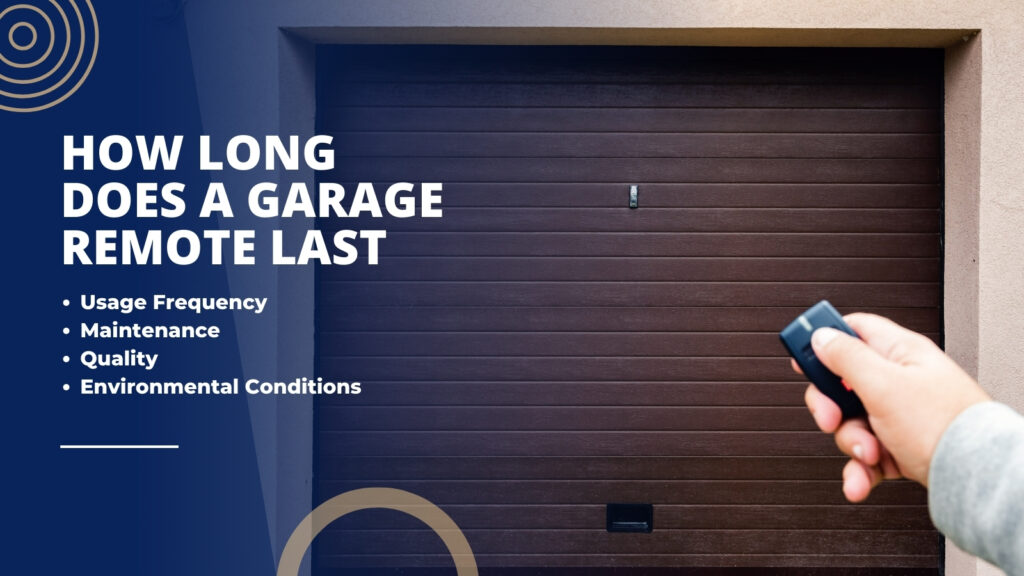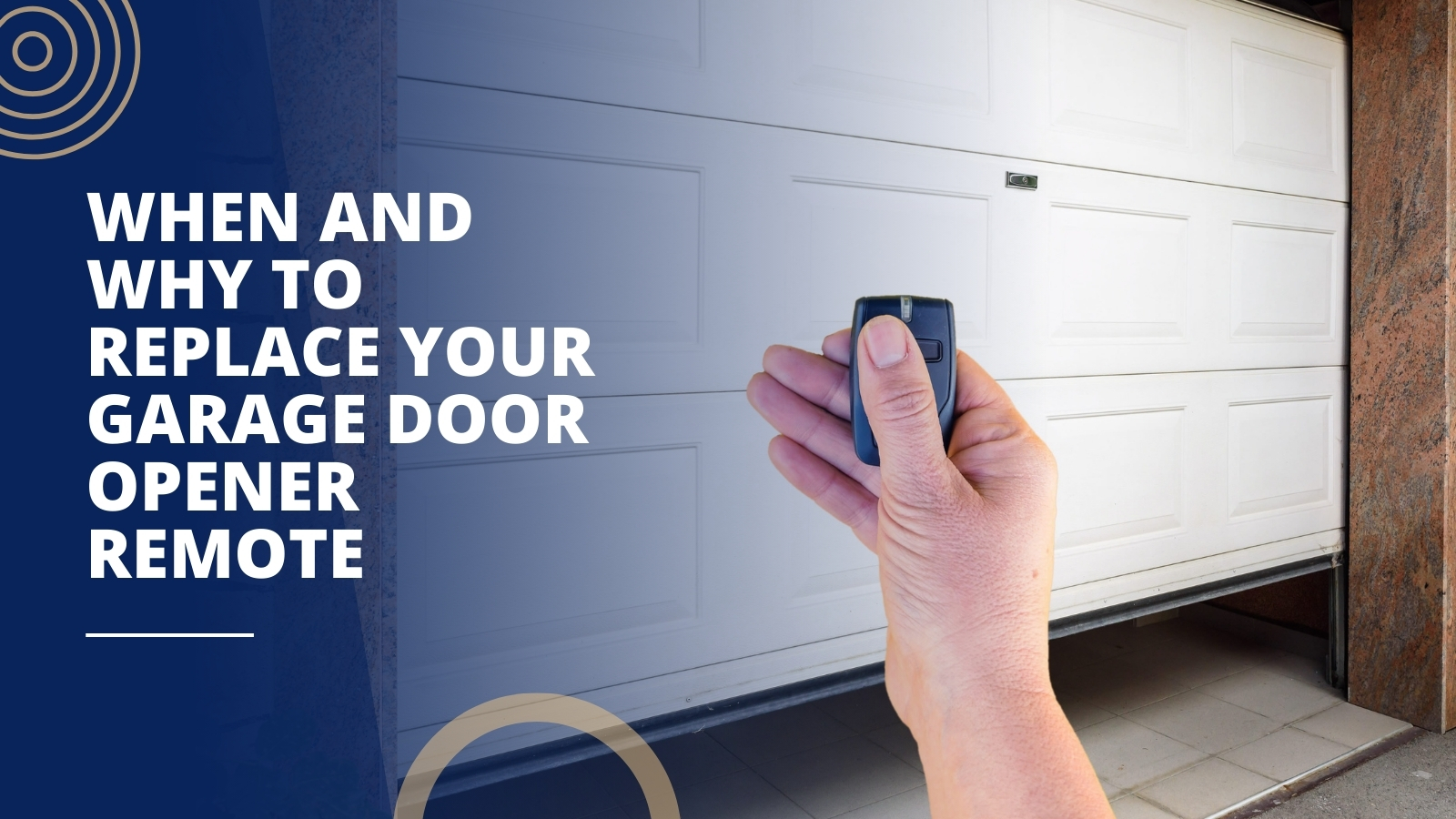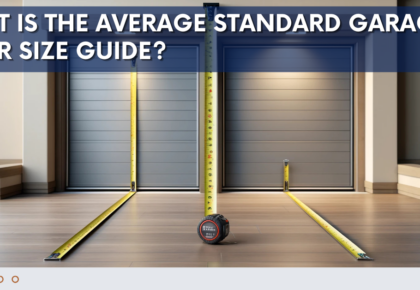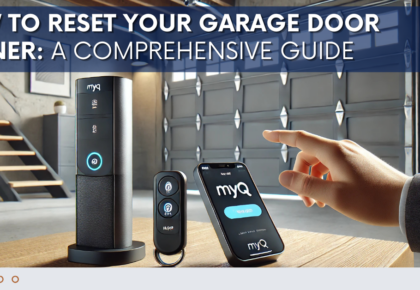When Should I Replace My Garage Door Opener Remote?
Knowing how and when to change your garage door opener remote is essential to the security and functionality of your door. Following are some of the signs that tell you it is time to replace:
- Frequent Malfunctions: It may be time for a new one if your remote keeps not opening or closing the door.
- Delayed Response: The visible delay from when the button is pressed and the door’s response can be a symptom of a problem.
- Physical Damage: Cracks, worn-out buttons, or any other kind of physical damage may call for replacement.
- Intermittent Operation: If the remote works only once in a while, it shows that there may be some internal problems.
- Battery Drain: If the battery is draining too quickly, this may result from an internal fault within the remote.
Add to these signs just the age of the remote. Technology marches forward day by day, and years-older remotes may miss some security inherent in the newer ones.
Why Replace Garage Door Opener?
There are several critical reasons you will need to replace your garage door opener remote:
- Security: In particular, older ones or faulty remotes pose a security risk by providing impromptu access. Modern remotes make use of rolling code technology that subtly changes the code each time it transmits, so it’s tricky for intruders to hack.
- Convenience: A good remote ensures that there aren’t any hiccups with its operation. Newer remotes, in most cases, add functions such as being able to operate multiple doors or integrate the device with home automation systems.
- Upgraded Features: The reason for this replacement is due to the new features arriving in the newer remotes. Some feature smartphone integration and much-advanced security protocols, such as many modern systems that enable you to check on your garage door status from your phone or give you a notification in case the door has been left open by mistake.
Why Do Garage Door Remotes Fail?
Garage door remotes have many reasons for failing, such as:
- Battery Problems: The most common cause of failure is that the batteries are just worn out. All batteries naturally have a limited life and will gradually lose their ability to hold an electrical charge over time.
- Signal Interference: Other electronic devices around could create interference in the signal. This might be because of other wireless devices at your place, like routers and cordless phones.
- Wear and Tear: Buttons and internal components will wear out with constant use. Dust and dirt will collect inside and cause the remote to malfunction.
- Elements Exposure: Moisture, dust, temperature extremes—all of these can make a remote wear out. For example, if you happen to leave your remote in a car during summer or on a winter night, it will throttle its life.
- Software Glitches: There may be a requirement to update or reset the software of the remote.
How Long Does a Garage Remote Last?

On average, a remote for garage door openers will work for 10 to 15 years. But the real lifetime depends on:
- Usage Frequency: This can eat into the lifespan of the remote. If you operate your garage door several times a day, then the buttons on the remote and other internal components will wear sooner.
- Maintenance: Proper service with changing of batteries, and the like—could extend its life. Cleaning the remote and putting in new batteries just before the old one is about to be completely drained help in maintaining it.
- Quality: High-quality remotes could last longer. On the other hand, good quality is always long lasting, and an investment in one may actually turn out to be money-saving by way of much-reduced replacement frequency.
- Environmental Conditions: Keeping the remote away from extreme temperatures or moisture can help in the longevity of the remote.
What Wears Out a Garage Door Opener?
Some of the things that can wear out a garage door opener include:
- Mechanical Stress: Repeated operation by the opener subjects its different constituents to a certain amount of stress, due to which they go out of order. The motor, gears, and chains are most prone to wearing.
- Environmental Factors: Exposure to moisture, dust, and extreme temperatures can cause wear. Humidity can lead to rust, while dust and dirt can clog moving parts.
- Electrical Problems: The opener can be ruined by power surges and short circuits. A surge protector can help prevent this to a degree.
- Inadequate or Neglected Maintenance: Lack of lubrication and checking for loose components can lead to its early wear.
Can I Just Buy a New Garage Door Remote?
Yes, you can. While purchasing a replacement garage door remote, consider the following:
- Compatibility: Be sure to check the model compatibility of your garage door opener with the new remote. You can do this by looking up the manufacturer’s website or manual for information on compatibility.
- Features: Consider remotes that have multi-button features or smartphone integration or anything that makes life easier. Some remotes will operate more than one door, and these may be of benefit if you have more than one garage.
- Brand: Go for a remote from a reputable brand known for its quality and reliability. Universal remotes are also available, which you can program to work with most garage door openers.
- Programming Ease: Some universal remote controls are easier to program than others. Look for one that has clear instructions or backing online.
Do Garage Door Openers Get Weaker Over Time?
Reasons that can make the garage door opener weak over some time include:
- Mechanical Wear: This wear can occur in parts like gears and motors. Proper lubrication and maintenance would reduce this type of wear.
- Signal Degradation: This can lead to a drop in intensity regarding its remote signal over a period of time. It can either result from wear and tear on the internal components that make up the remote or due to other nearer sources of electronic devices.
- Battery Decline: Older batteries may not be as effective at holding their charge as new ones. Changing the batteries periodically can help to maintain the remote’s performance.
- Spring Tension: There’s another component of the garage door that may affect the performance of the opener, and this is the springs. As they wear out, it makes an opener have to work harder to lift a door, giving the impression that the opener is getting weak.
How Do I Know If My Garage Door Opener Is Dying?
The following are some of the signs that indicate your garage door opener could be failing:
- Noisy Operation: Unusual noises during its operation could also be a sign of mechanical problems. Grinding or squeaking, most of the time, is an indication of worn-out parts.
- Slow Response: If it opens or closes slower than usual, this might indicate a problem. This may be due to a weak signal, dying battery, or mechanical wear.
- Intermittent Operation: If the opener is operating only intermittently, then it may be reaching the end of its life. It may be a case of worn parts or some sort of malfunctioning in the electronics.
- Frequent Stops: If the door stops frequently while opening or closing, there could be a problem with the motor or it might be off-balance.
- Remote Range Reduction: In case the remote range has reduced drastically, then it can be a fault of weakening signal strength or interference.
Can I Use My Smartphone as a Garage Door Opener?
Yes, most of the modern garage door openers come with smartphone integration, which allows:
- Remote Access: This one is very useful, especially when someone needs access in your garage and you happen to be somewhere else. You can open or close your garage door from anywhere.
- Enhanced Security: Know the real-time status of your garage door. You can receive alerts if the door is opened or left open, providing added peace of mind.
- Convenience: No real remote will need to be required. You would control your garage door anytime in case you ever forget or misplace the remote with the help of a smartphone app.
- Smart Home Systems Integration: The vast majority of contemporary garage door openers now integrate with smart home systems like Amazon Alexa, Google Assistant, or Apple HomeKit, enabling voice control and automation.
You’ll need an opener that works with your smartphone, along with its proprietary app. Some popular models include MyQ from Chamberlain, Nexx Garage, and Garadget.
How Do I Choose a Garage Door Remote?
Things to consider while choosing a replacement garage door remote:
- Compatibility: Ensure it works with your opener; check the model number on the opener and match it with the remote.
- Features: Decide if you need general or high-end features, such as smartphone control. Some come with multiple buttons for opening additional doors or other actions, like lighting control.
- Brand Reputation: Go for reputed brands known for reliability and quality, reading through the reviews and ratings which will be helpful in making a decision.
- Ease of Use: Get remotes that can be easily programmed or are easy to use. Some remotes have a number of user-friendly features, such as LED indicators and an ergonomic design.
- Price: Do consider your budget but know that, often, paying the least expensive price might not afford you the best durability or features.
Can I Use a Different Remote for My Garage Door?
Yes, you can. Just make sure it is compatible with your opener. Universal remotes are always handy and offer:
- Versatility: Can be programmed to work on multiple garage doors. This is quite handy if someone has more than one garage, or you just want a single remote for controlling various devices.
- Convenience: Perfect if you lost your original remote or just want a backup. Most universal remotes come with easy programming instructions and could be quite cost-effective.
- Availability: Widely available in stores and online, making it easy to find a replacement quickly.
In preparing for the universal remote, ensure that it is going to be most compatible with your garage door opener in both frequency and technology involved—for instance, a fixed or rolling code system.
Practical Tips for Maintaining Your Garage Door Opener Remote
Proper maintenance will help squeeze the most from your opener remote and ensure its reliable operation. Following are some practical tips:
- Replace Batteries Regularly: Replace batteries at least on an annual basis or if you find the remote range has decreased.
- Clean the Remote: Use a soft, dry cloth to clean off dust and dirt accumulated on the remote. Avoid harsh chemicals subject to damage plastic.
- Proper Storage: Store the remote in a cool, dry place. Do not leave it in direct sunlight or inside your car during extremely high or low temperatures.
- Check for Physical Damage: Be on the lookout for crack development or other kinds of physical damage on the remote. Replace it if there is considerable wear observed in it.
- Reprogram If Needed: If the remote malfunctions, instructions given by the manufacturer will be useful in reprogramming the remote.
Common Problems with Garage Door Opener Remotes and How to Fix Them
A number of common problems occur with garage door opener remotes. Here’s how to fix some:
- Remote Not Working: First of all, check the batteries. If they are fine then reprogram the remote and make sure there is no interference from other electronic devices.
- Long Range: Batteries may have to be replaced, and the remote cleaned. Ensure there are no obstacles between the remote and opener.
- Intermittent Operation: Check for any loose or damaged wiring in the opener. If it persists, replacement of the remote is advisable.
- The Door Opens/Closes by Itself: This will be as a result of the stuck button on the remote or interference from other remotes. Check and clean the remote buttons; reprogram the remote if necessary.
The Evolution of Garage Door Openers and Remotes
Garage door openers and remotes have evolved significantly. Now you can appreciate this modern innovation:
- Early Models: The very first models of garage door openers were manual. Remote control technology was introduced during the 1950s, using simple radio signals.
- Improved Security: Rolling code technology was introduced by manufacturers in the 1980s as a security improvement measure. Any time one uses a remote, this technology changes the code; thus, it prevents the grabbing of a code.
- Smart Technology: Openers can now be integrated with smart home systems to features that include smartphone control, voice activation, and real-time alerts.
- Eco-friendly Designs: New garage door openers are more power efficient, using less power. Eco-friendly designs also include solar-powered units.
Embrace Modern Convenience and Security
Replacing a garage door opener remote is quite vital for ensuring the continuous safety and proper working condition of the device. Learn to identify some of the warning signs when it’s dying, why you would want to replace it, and how you can select the right one for smooth, reliable operation.
Whether you opt for a traditional remote or one controlled by your smartphone, knowing what’s out there will help you make the best decision for your specific needs. Proper maintenance and staying current with changing technology will enhance performance and safety even more, bringing peace of mind and convenience regarding a garage door.









1 thought on “When and Why to Replace Your Garage Door Opener Remote”
Pingback: What to Do If Your Garage Door Remote Isn’t Working - MNGarageSquad